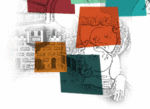Freaky: Queer Art Conference, Workshop, Exhibition
type=project
at Ballhaus Naunynstraße, Berlin
August 28th–30th 2009
The conference will develop a queer-theoretical perspective on contemporary art practices. Four art and queer theorists will intensely and publicly work with, on, and about four art works, which will be on display during the conference. A film and performance programme and a workshop will bring in further perspectives, artistic material and visual/linguistic practices.
A freaky art theory and art production may be able to refer critically to the history of coercion and enforcement in the displaying of bodies, of ‘staring’ as a constitutive moment of a modern visual regime, and of practices of categorization–in knowledge production as well as in the organisation of the social. While these cultural practices have been widely problematized, the thesis of the conference is that they also may become the entry point of queer knowledge production. By focusing on the emphasis that the historic usage of the term freak puts on ‘strangeness’ and the decisive production of ‘space for difference,’ freaky theory and art production may open up a “resistance against cultural homogenization” (Teresa de Lauretis).
Two main questions should be raised in the debate around difference:
A Queer Freak seems to be useful as an intersectional figure, able to represent all kinds of differences without necessarily producing a category or identity. Freak figures do not allow any definition of a norm from which they deviate. They may be shown as dysfunctional or incompatible with social and economic requirements. On the other hand they may have skills that are somehow strange and do not always get recognition but still have a certain value and may pay. A freak image may show embodiments that cannot be described in gender or ethnic categories. Or it may represent bodies without actually showing them. What kinds of these works are there? What might such presentations require of a reading of these works? What might a freaky art theory look like?
Queer Exotics poses the question of why imagery of the exotic and the Oriental is often used in queer art. Is it able to refer critically to a history of colonialism and intervene into the meaning of non-Western fantasies for the construction of whiteness and the West? Does it produce a figure of distance–distance to whiteness, to heterosexuality or to the two-gender system?
The film programme is curated by Karin Michalski/clipclub Berlin and will present works by Klara Lidén, Ulrike Müller, Nao Bustamante, Wu Ingrid Tsang, Pauline Boudry & Renate Lorenz, Line Karlström, Rashawn Griffin, Guy Ben-Ner, Harry Dodge & Stanya Kahn, Tina Takemoto and some others (on August 28th and 29th).
The conference will be organised by the interdisciplinary research project ‘Performance Cultures’ (Freie Universität Berlin) and the Working Group on ‘Precarisation of Sexual and Gendered Identities.’
The conference will be documented by a publication.
A detailed program will be published prior to the conference. Information on the workshop: please write to Renate Lorenz; r [dot] [dot] lorenz![]() fu-berlin [dot] de.
fu-berlin [dot] de.
speakers:
Elisabeth Lebovici, Paris
Robert McRuer, Washington
Kobena Mercer, London
Catherine Lord, Los Angeles
art works by:
Nao Bustamante
Ines Doujak
Latifa Echakhch
Rashawn Griffin

